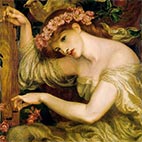
Pre-Raphaelite Brotherhood Artists Index
Alphabetical Index of the Great Masters of Pre-Raphaelite Brotherhood
The Pre-Raphaelite Brotherhood was a group of young British painters who banded together in 1848, reacting against the unimaginative and artificial historical painting of the Royal Academy. The group was founded by William Holman Hunt, John Everett Millais, and Dante Gabriel Rossetti, who were disillusioned by what they believed to be the stuffy conventions of the Academy as a microcosmic artistic reflection of the values of society.
The Pre-Raphaelites sought to express a new moral seriousness and sincerity in their works. They rejected the conventions of academic art and instead looked to the art of the early Renaissance before the time of Raphael, hence the name "Pre-Raphaelite." They were known for their attention to detail, use of vibrant colors, and incorporation of literary and mythological themes. They often painted outdoors, preferring naturalistic settings to the artificiality of the studio. They also focused on creating a moral and spiritual message in their art, often drawing on religious themes.
One of the earliest and most famous works of the Pre-Raphaelites was Rossetti's painting "The Girlhood of Mary Virgin," which was the first Pre-Raphaelite work to appear in public. It featured the secretive initials "PRB," indicating that the artist was a member of the newly established Pre-Raphaelite Brotherhood. Other notable works by the Pre-Raphaelites include Millais' "Ophelia," Rossetti's "Beata Beatrix," Hunt's "The Awakening Conscience," and Ford Madox Brown's "Work".
The Pre-Raphaelites had a significant impact on the art world of their time, and their influence can still be seen in contemporary art today. They were particularly influential in the Arts and Crafts movement, which rejected mass production and celebrated traditional craftsmanship and individualism. The Pre-Raphaelite ideals of sincerity, attention to detail, and moral purpose also inspired later artists such as the Symbolists and the Aesthetic movement.
The Pre-Raphaelites sought to express a new moral seriousness and sincerity in their works. They rejected the conventions of academic art and instead looked to the art of the early Renaissance before the time of Raphael, hence the name "Pre-Raphaelite." They were known for their attention to detail, use of vibrant colors, and incorporation of literary and mythological themes. They often painted outdoors, preferring naturalistic settings to the artificiality of the studio. They also focused on creating a moral and spiritual message in their art, often drawing on religious themes.
One of the earliest and most famous works of the Pre-Raphaelites was Rossetti's painting "The Girlhood of Mary Virgin," which was the first Pre-Raphaelite work to appear in public. It featured the secretive initials "PRB," indicating that the artist was a member of the newly established Pre-Raphaelite Brotherhood. Other notable works by the Pre-Raphaelites include Millais' "Ophelia," Rossetti's "Beata Beatrix," Hunt's "The Awakening Conscience," and Ford Madox Brown's "Work".
The Pre-Raphaelites had a significant impact on the art world of their time, and their influence can still be seen in contemporary art today. They were particularly influential in the Arts and Crafts movement, which rejected mass production and celebrated traditional craftsmanship and individualism. The Pre-Raphaelite ideals of sincerity, attention to detail, and moral purpose also inspired later artists such as the Symbolists and the Aesthetic movement.